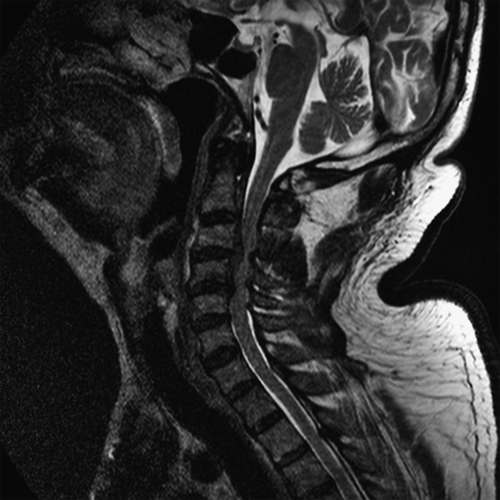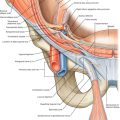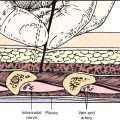CHAPTER 9
Trapezius Strain
Definition
Trapezius strain is often considered a part of the myofascial pain syndrome (MPS). This is a common diagnosis of patients who present to outpatient clinics for musculoskeletal pain disorders [1]. There is no standard definition of trapezius strain or MPS; however, MPS is described as a disorder characterized by acute and chronic nonspecific pain that affects a small number of muscles and involves single or multiple trigger points that are usually located in tight bands within the affected muscles [2]. The pain in this area must not be mistaken for cervical radicular pain that involves the shoulder girdle and the upper limb [3]. The etiology of trigger point formation is not known, but the most accepted hypothesis focuses on the existence of dysfunctional end plates leading to a perpetuated shortening of the muscle [4,5].
Trapezius strain is thought to be due to common repetitive strain or stress injury associated with carrying light loads and certain postures, such as that with working on a computer for long periods [6]. Myofascial trigger points can be the main cause of neck and upper back pain, and the trapezius muscle is the most commonly studied [7]. The condition can also result from acute causes, such as a whiplash injury.
Symptoms
Patients typically complain of a sore or aching sensation in the region of the upper trapezius muscle. Patients may also complain of posterior neck and shoulder pain. Some may have associated posterior headaches, difficulty with sleeping due to shoulder pain, and interscapular area pain. The symptoms can be constant and relieved by rest and worsened with activity. There can be increased pain with cervical movement and hence limitation in neck range of motion. The pain is regional and does not follow spinal segmental or peripheral nerve distribution. Patients may often report that the symptoms are partly relieved with the use of heat or cold modalities and focal pressure.
Physical Examination
The importance of the physical examination is to rule out other conditions that may be causing the patient’s symptoms, such as a radiculopathy, peripheral nerve injury, cervical dystonia, or some other condition that may be suspected on the basis of the history. A neurologic and musculoskeletal examination focusing on the neck and upper body should be done in addition to a general examination. Other evaluations include cranial nerve function, especially checking the spinal accessory nerve; sensation to light touch and pinprick about the face, upper limbs, and torso with attention to dermatomes and cutaneous nerve distribution; muscle stretch reflexes; and strength testing. The findings on neurologic examination are typically normal in primary trapezius strain. The patient may present with a forward head posture, scapular protraction, and compensatory cervical hyperextension. Muscle palpation about the neck and shoulder girdle may reveal tender areas and trigger points, especially in the trapezius muscle. A shoulder examination should be carried out to assess for shoulder disease.
Functional Limitations
Trapezius muscle strain can limit activities requiring the arm to be outstretched in front or to the side. There can be pain with rotation of the head and hence function limitation, such as turning the head for a shoulder check when driving. Pain in certain positions may interfere with restful sleep and thus affect overall function.
Diagnostic Studies
There is no specific test that is used to diagnose trapezius strain. It is a clinical diagnosis based on the history and physical examination. Radiologic studies, electrodiagnostic testing, and laboratory testing can be helpful in ruling out other potential conditions, such as cervical radiculopathy, cervical degenerative disease, shoulder disease, or inflammatory process. Newer musculoskeletal imaging techniques show promise for future application as diagnostic tools to objectively measure the presence or absence of myofascial trigger points. Magnetic resonance elastography is a research tool that is used to measure the stiffness of biologic tissues; it has been reported to successfully identify and quantify myofascial taut bands [8]. Musculoskeletal ultrasound is another tool that is changing the approach to the diagnosis of musculoskeletal conditions, including muscle strains [9,10].
Treatment
Initial
Initially, the patient should be educated about the condition and its usual benign course. The importance of appropriate activity, posture, and exercise is stressed. The goal is to break the cycle of improper posture, overuse and strain, and deconditioning. This may require a short-term course of muscle relaxants, anti-inflammatory medications, analgesics, and modalities.
There is little evidence in the literature that any of the muscle relaxants provide clear benefit in patients with MPS. A Cochrane review that evaluated the efficacy of cyclobenzaprine for the treatment of MPS found that insufficient evidence supports its use because of a lack of high-quality randomized controlled trials [11]. A review article that assessed the efficacy of numerous muscle relaxants for the treatment of MPS concluded that insufficient evidence exists to support the use of tizanidine, alprazolam, or diazepam monotherapy, but evidence is supportive for the use of clonazepam in the treatment of MPS [12]. Similarly, there is insufficient evidence in favor of antidepressants (other than amitriptyline), anticonvulsants, topical analgesics, nonsteroidal anti-inflammatory medications, and other analgesics [13].
Electrical stimulation, laser therapy, and magnetic therapy did not show clear evidence to support use in the treatment of MPS. Ultrasound-based interventions appear to have a role in providing short-term and intermediate-term improvement in pain and function, especially as an adjunctive therapy [13].
Rehabilitation
The goals of therapy (occupational or physical) are to reduce pain and to improve function. Depending on the severity and chronicity of the condition, the patient may have developed secondary problems related to muscle shortening, weakness, and reduced range of motion. The initial goal of the therapy is to reduce the local muscle spasms and pain, followed by appropriate stretching and strengthening to minimize the risk of recurrent problems. Physical modalities such as heat and cold therapy combined with massage can help relieve some of the symptoms by relaxing the muscles. Stretching is initially targeted to specific portions of the trapezius muscle. The cervical extensor and scapular stabilizers are strengthened. The patient should be set up with a home program to continue with the stretching and strengthening exercises. A primary goal of rehabilitation should include evaluating and appropriately modifying tasks that exacerbate the patient’s symptoms. For example, carrying heavy baskets of laundry, driving, typing on a computer keyboard, and many other daily tasks may exacerbate symptoms. If indicated, an ergonomic assessment of the patient’s workstation should be carried out to help maintain an appropriate upper body posture.
Procedures
Procedures include acupuncture, dry needling, and trigger point injections. A review of dry needling therapy trials in patients with MPS shows inconclusive evidence in favor of or against the use of superficial dry needling therapy for the treatment of MPS [13]. There is insufficient evidence to conclude that trigger point injections are more effective than dry needling alone or placebo. Limited evidence exists to support the use of trigger point injections for the treatment of MPS (grade B recommendations) [13]. Botulinum toxin injections have been studied. A Cochrane review found that only one of several trials that met the selection criteria was effective in treating pain from trigger points [14–17]. The conclusion of this review was that current evidence does not support the use of botulinum toxin A for the treatment of trigger points in MPS [18]. Another review of predominantly level 1 studies found three studies in favor of botulinum toxin injections and eight against or equivalent with control intervention or placebo [13].
Surgery
Surgery is not indicated for treatment of trapezius strain.
Potential Disease Complications
If the patient’s condition is left untreated, problems of reduced range of functional motion of the neck and shoulder, muscle atrophy, and secondary chronic pain may develop. These can result in personal and occupational disability.
Potential Treatment Complications
Oral medications that may be used for analgesia or muscle relaxation can have side effects or interactions with other drugs the patient may be taking. The nonsteroidal anti-inflammatory drugs may produce gastropathy, renal toxicity, hepatic toxicity, bleeding, exacerbation of asthma, and central nervous system effects. Muscle relaxants and tricyclic antidepressants may cause sedation and anticholinergic side effects, such as dry mouth, urinary retention, orthostatic hypotension, and weight gain. Botulinum toxins can cause asthenia, dysphagia, influenza-like symptoms, and muscle weakness. Trigger point injections can result in local ecchymosis and pain.







